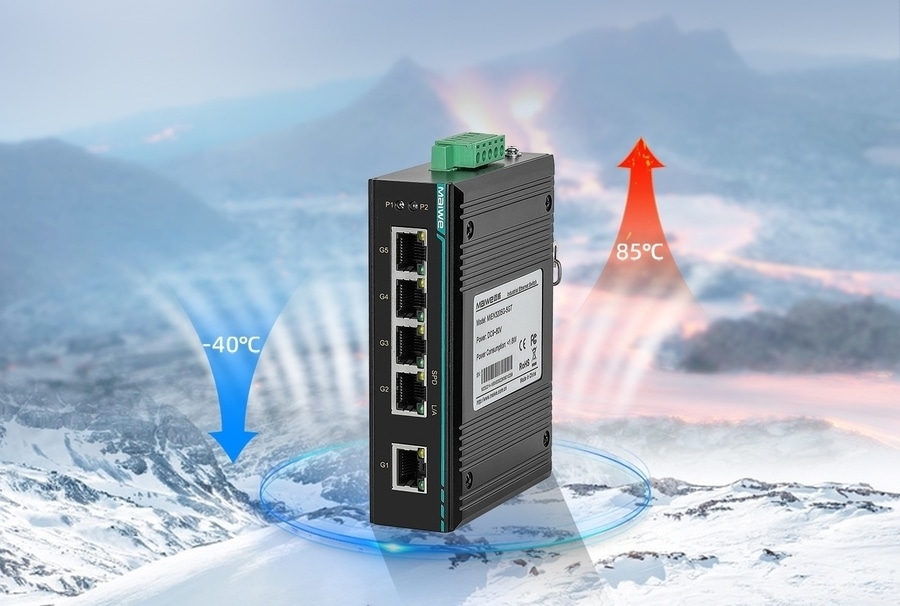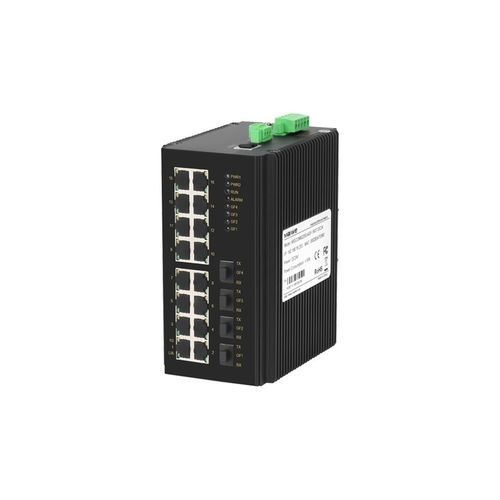
#Industry News
Industrial Switch vs Normal Switch, What's the Difference
Industrial Ethernet Switch vs Normal Ethernet Switch
What is industrial ethernet switch? This definitive guide goes beyond the common pointers like working temperature, rugged design, voltage, and installation methods, providing a nuanced understanding that truly distinguishes a genuine industrial switch from its commercial counterpart, unraveling the essence of these distinctions to make informed decisions in choosing the right switch for your specific needs, offering genuine assistance to customers and industry professionals alike.
Normal Switch Definition
A network switch (also called switching hub, bridging hub, and, by the IEEE, MAC bridge) is networking hardware that connects devices on a computer network by using packet switching to receive and forward data to the destination device. Multiple data cables are plugged into a switch to enable communication between different networked devices. It finds frequent application in Local Area Networks (LANs), particularly in scenarios where a router or hub with limited ports is insufficient to cater to the connectivity needs of multiple terminal networking devices, such as computers and servers housed in server cabinets and data centers.
ethernet switch work topology
Industrial Switch Definition
An industrial switch, also called a hardened switch, is a type of network switch designed for use in industrial settings, it still belongs to the network switch, but cannot be replaced by a simple SMB ethernet switch, commercial switch, data center switch, etc,. The industrial ethernet switches are usually designed to avoid vibration or shocks that could make cables fall out and to meet industrial EMC (electromagnetic compatibility) standards. By comparison, business normal IT switches are less resistant to vibrations, shocks, and electrical noise currents that can cause component burnout and other electrical damage.
The Difference Between Industrial Switch and Normal Switch
The differentiation between industrial switches and typical commercial switches lies in their design, functionality, and robustness to meet distinct operational requirements. Industrial switches are engineered to withstand harsh environmental conditions, temperature variations, and electromagnetic interference commonly encountered in industrial settings.
Switch Port Difference
Normal switches typically feature Ethernet ports, such as SFP fiber ports or RJ45 copper ports, for connecting networking devices. In contrast, industrial switches go beyond this standard configuration, often incorporating additional port types. These may include serial ports, commonly employed in applications requiring simple, low-speed interfaces like industrial automation systems, scientific instruments, point-of-sale systems, and various industrial and consumer products. Additionally, industrial switches may incorporate M12 ports, utilizing connectors known for their reliability, compact design, and resistance to moisture and vibration. M12 switches find application not only in industrial settings but also in transportation systems, marine environments, and other scenarios where robust and secure connections are crucial. It's noteworthy that while most normal switches may use the serial port primarily for debugging purposes, industrial switches leverage this port like RS232 RS485, for both debugging and serial communication with compatible devices, showcasing their enhanced versatility in diverse operational contexts.
industrial switch and business switch port difference
Switch Case Difference
In terms of material, normal switches usually come with plastic and iron case while industrial network switches favor aluminum enclosures, a material chosen for its resistance to rust and durability. The aluminum casing serves as a protective shield, minimizing the risk of corrosion and damage to internal components, thus ensuring the longevity and reliability of the industrial switch in challenging operational conditions.
When it comes to design aesthetics, normal switches typically embrace a sleek and conventional appearance. On the flip side, industrial switches often opt for a more robust and rugged design, strategically engineered to withstand elevated temperatures and resist the accumulation of dirt or dust. This hardy construction is not merely an aesthetic choice; it serves a functional purpose, making industrial switches better suited for demanding environments where resilience to extreme conditions is imperative. Additionally, some industrial switches, known as embedded switches, forego traditional enclosures altogether, offering a specialized solution for applications where space optimization and direct integration into equipment or machinery are paramount. Whether deployed in manufacturing facilities, outdoor installations, or other challenging settings, the durability, adaptability, and diverse form factors of industrial switches become essential attributes, ensuring reliable performance in diverse operational landscapes.
industrial switch and business switch case difference
Switching Protocol Difference
In industrial and commercial networking scenarios, one significant difference lies in the switching protocols employed. Industrial networks often utilize protocols such as PROFINET, EtherNet/IP, or Modbus TCP, which prioritize real-time communication, determinism, and reliability to meet the stringent requirements of industrial automation. On the other hand, commercial networks commonly rely on protocols like Ethernet and TCP/IP, emphasizing data throughput and flexibility, as commercial applications typically don't have the same real-time demands as industrial processes. The choice of switching protocol plays a crucial role in ensuring optimal performance and meeting the specific needs of each environment.
Mounting Type Difference
When it comes to mounting options, normal switches offer versatile mounting solutions such as desktop, rack mount, and wall mount configurations, catering to diverse office, data centers, and server rooms setups. On the other hand, industrial switches extend this range with two additional options: embedded and DIN-rail mounted configurations. In contrast, industrial switches, with the inclusion of embedded mounting, cater to applications where seamless integration into machinery or equipment is paramount. This makes them ideal for underground mining and automation systems where space is at a premium. The DIN-rail mount option further enhances their adaptability, allowing for secure and efficient installation in industrial settings, such as control panels and cabinets.
industrial switch mounting types
In summary, while normal switches offer versatile mounting options suitable for traditional networking environments, industrial switches extend their utility to specialized applications, providing a spectrum of mounting choices to meet the unique demands of industrial landscapes.
Power Supply Difference
The power supply is a very important part of industrial switches. Power failures generally account for more than 35% of the equipment failure rate. To avoid the trouble of power failure, the industrial Ethernet switch generally supplies a dual power supply backup. While most normal switches in the market usually support a single power supply, which can only meet the basic operation requirements.
Absolutely, industrial switches often feature a wider voltage input range to accommodate fluctuations and variations in power supply commonly encountered in industrial settings. Another notable distinction is their power input socket appearance, which is tailored to the power supply methods prevalent in industrial and commercial scenarios. Notably, industrial plugs adhere to significantly higher safety requirements compared to their commercial socket counterparts.
These robust industrial plugs find extensive applications across various industries such as iron and steel smelting, petrochemical, electric power, electronics, railways, construction sites, airports, mining sites, water supply and drainage treatment plants, and more. The power supply employed for industrial switches typically operates within a broader voltage range, such as 90-264V AC or 18-36V DC.
industrial switch and business switch power supply difference
Working Temperature Difference
Industrial Ethernet switches, due to the deployment scenarios, have to withstand poorer conditions than the commercial counterparts. Therefore, they are built and tested with a wide operating temperature range of -40~75℃, while a normal ethernet switch only works in 0-50℃.
industrial switch working temperature range
Cooling Difference
While commercial-grade switches rely on fan cooling with holes on the casing, susceptible to dust accumulation, industrial-grade switches do not have fans, but rely on rugged design to resist heat better, and any buildup of dirt or dust. As the aluminum rejects heat better than iron, and this can prevent overheating and extend the life of aluminum alloy shell switches.
Conclusion
An industrial switch is a type of network switch designed for use in industrial settings, it still belongs to the network switch, but cannot be replaced by a simple SMB ethernet switch, commercial switch, data center switch, etc,. Beyond the surface-level considerations of temperature, design, voltage, and installation, we've delved into the essence of what truly sets a genuine industrial switch apart from its commercial counterpart. Armed with this nuanced knowledge of disparities between industrial and commercial switches, you're empowered to make informed decisions when selecting the right switch for your unique requirements. We hope this guide has provided genuine assistance to both customers and industry professionals, fostering clarity in the realm of industrial and commercial networking solutions.







